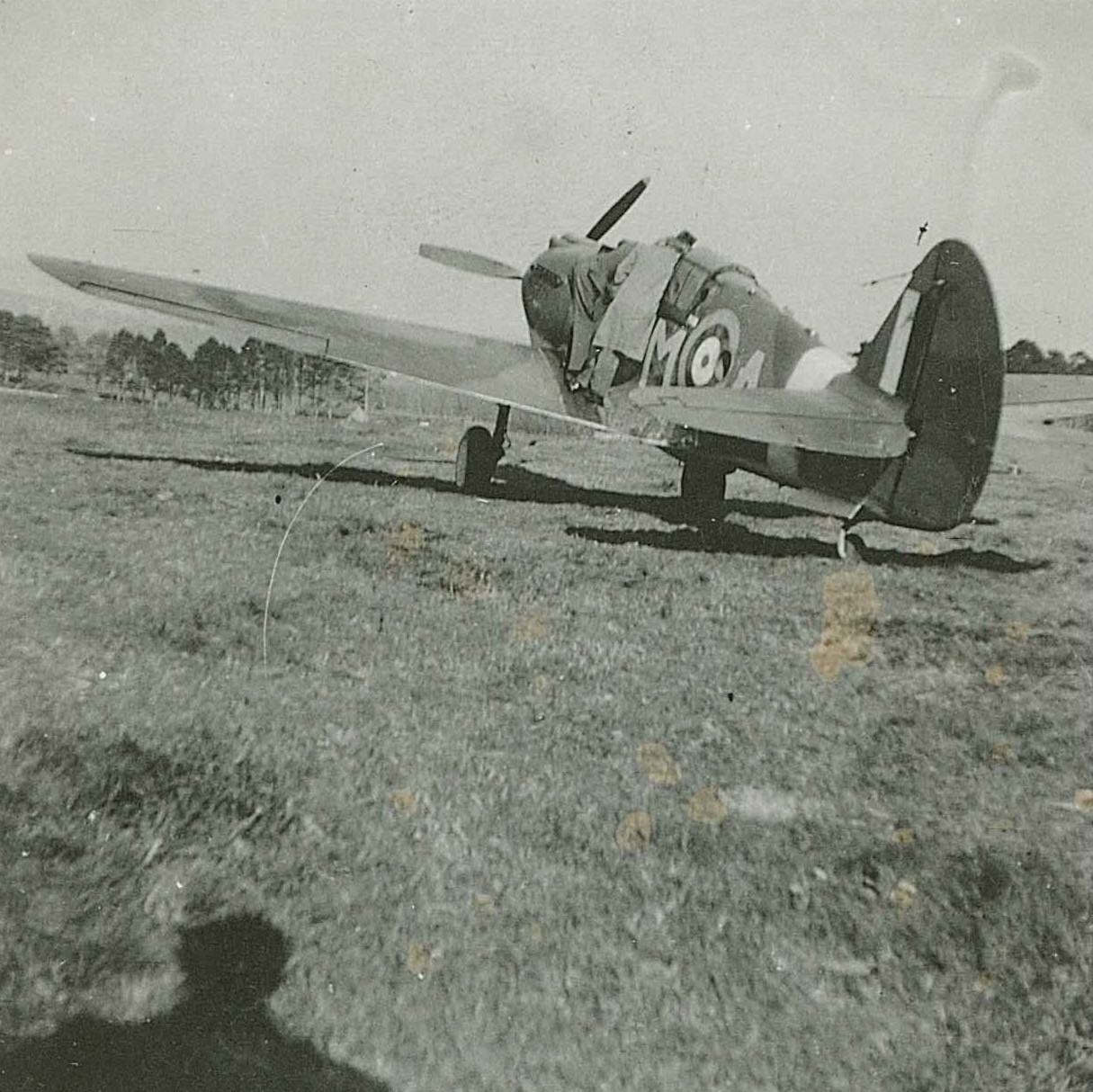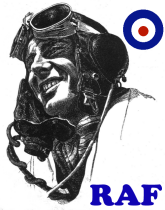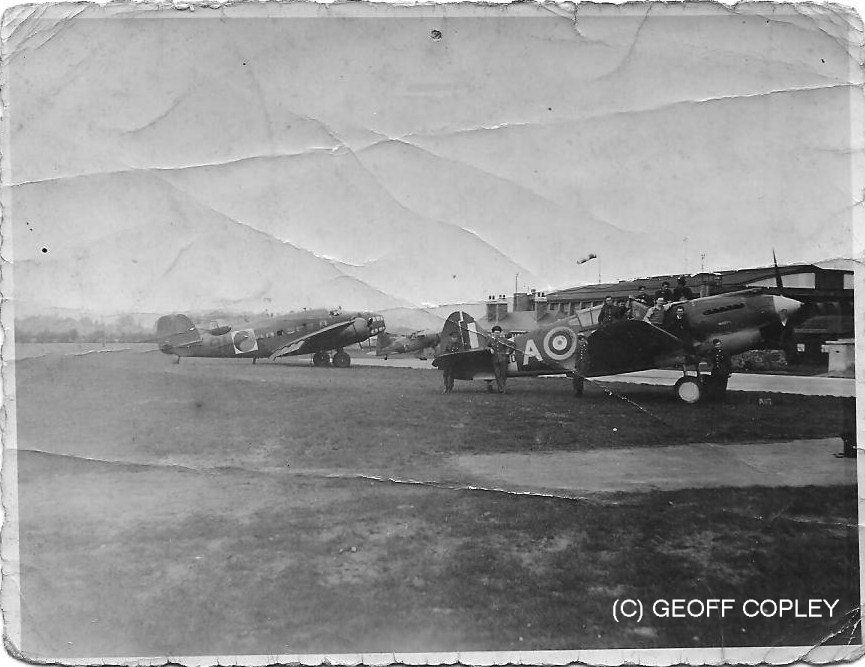Curtiss Tomahawk, Arklow, Wicklow, April 1942
On April 24th 1942, an aircraft was sighted by Irish military posts at Sandycove, Dalkey and then Bray. Reports were later received that an aircraft had made a landing in a field near Arklow, County Wicklow at 14:05 hours. The location was in the townland of Kilcarra on the land of a William Appleby.
The pilot gave his name to the Irish military as F/O Donald
Newton Kennedy, serial number 93835. They also recorded
addresses he provided as being; ‘52
Bolshore Road, Handforth, Cheshire' and '12 NCR, Lisburn, Co. Down', the
latter being the address his wife resided at. F/O Kennedy
reported that he had been flying from Maghaberry in Northern
Ireland and had suffered a compass failure. His decision to land
was due to his running low on fuel. The aircraft was undamaged
in the landing but it was determined that the aircraft could not
take off from the same field. The photo shown here was
taken by Mr Thomas J Cullen, a Dublin based architect who
happened to be working in the Arklow area in early 1942 and
appears to have had the opportunity to photograph AH920 on the
ground.

Donald Newton was taken from Wicklow to the British internment
camp in the Curragh and spent the night of the 24th of April
interned. It had been claimed or thought that day by the Irish
Authorities that his aircraft was pursuing German aircraft down
the Irish Sea. However, upon inspection of the aircraft it was
duly noted that while it was equipped with two nose guns, these
were fitted with neither barrels nor recoil mechanisms.
On the 25th of April, Acting Colonel Dan Bryan, Chief Staff
Officer of the G2 Branch penned a short memo to the Provost
Marshall of the Irish Army which read:
Forced landing of British Aircraft at
Kilcarra, near Arklow, on the 24th April, 1942.
A British Curtis Tomahalk single seater fighter
aircraft made a forced landing through lack of petrol at
Kilcarra, 1 mile SE of woodenbridge, Co. Wicklow, at
approximately 13.15 hrs. on the 24th instant. The
pilot who was unhurt communicated with the Arklow Garda who
arrived on the scene and took him into custody at about
14.00 hrs. He was subsequently removed to Arklow Garda
Barracks.
Particulars of the pilot are as follows:
93835 Flying Officer Donald Newtown Kennedy.
Home Address: 52 Bolshore Road, Hanfort, Cheshire.
Next of kin: Wife,
Address: 12, N.C.Rd., Lisburn, Co. Antrim.
Flying Officer Kennedy left Arklow under military
escort for the Curragh at 17.30 hrs. on the 24th and arrived
there at 19.35 hrs. when he was interned.
 Donald Newton
Kennedy was born on the 3rd of July, 1917 in Manchester. His
parents were Thomas Anderson and Dora Winifred Louise Pickworth
who had married in 1914 in Withington, Manchester. Donald’s
father was a First World War veteran who had served from late
1916 to the end of the war as a Clerk in the Army Pay
Corps. Donald attended Repton School in Derbyshire
between September 1931 and July 1934 and while there attended
the OTC, or Officers Training Corps.
Donald Newton
Kennedy was born on the 3rd of July, 1917 in Manchester. His
parents were Thomas Anderson and Dora Winifred Louise Pickworth
who had married in 1914 in Withington, Manchester. Donald’s
father was a First World War veteran who had served from late
1916 to the end of the war as a Clerk in the Army Pay
Corps. Donald attended Repton School in Derbyshire
between September 1931 and July 1934 and while there attended
the OTC, or Officers Training Corps.
The pilot had begun the war as a commissioned 2nd Lieutenant in
the 41st Royal Tank Regiment but took the opportunity to
transfer to the RAF and take the rank of Pilot Officer in Army
Co-Operation Command with RAF serial number 43959. The
differences between his officially published serial number and
that of the hand written one in the Irish Army report may simply
be a problem with illegible hand writing in the Irish
report. His transfer to and Commishion into
the RAF was published in the London Gazette in the summer of
1940. He undertook successful flying training with No. 9
Flying Training School between the 17th of August and the 4th of
November 1940. This was followed by a month at No. 1
School of Army Co-Operation.
Donald married Gladys Susannah Cook in the parish church of St
Thomas, Salisbury on 17 December 1940, just prior to his being
posted to Northern Ireland.
P/O Kennedy was posted to 231 Squadron with effect from 22 Dec 1940, being assigned to ‘A’ flight. He was promoted to the rank of Flying Officer in August 1941. The Squadron ORB, Summary of Events rarely mentions individual pilot duties but F/O Kennedy is mentioned as having completed two successful lives shoots, this time on the strength of ‘C’ Flight on 1st April 1942. On the 6th of April he carried out photo missions in a Lysander aircraft. The following day he completed a three aircraft navigation trip to Derry, Limavady and Rathlin Island. Again on the 8th of April he took part in a three aircraft formation flight to Newtownards from the base at Maghaberry. The 10th and 11th of April saw him complete successful artillery reconnaissance flights in a Tomahawk. His next name mention is a Lysander flight to Carlisle and back for navigation training and collection of stores. He was back on a Tomahawk artillery recon flight on the 20th of April.
Finally, on April 24th, the ORB records:
“A” Flight – F/O D.N.KENNEDY in
TOMAHAWK took off to attempt an ARTY/R in the ENNISKILLEN
district, as he did not arrive over the area P/O
D.H.R.Broadberry in a LYSANDER went to search for him. F/O
D.N.KENNEDY reported as having landed unharmed.

The aircraft that Donald Kennedy forced landed in Wicklow
was an American built Curtiss
Tomahawk IIA. A version of the Curtiss P-40B Warhawk
fighter, the Tomahawk IIA was equipped with some British
equipment and supplied in a batch of 110 aircraft. After
it was landed in the field near Arklow, a recovery team from the
Irish Air Corps at Baldonnel, south west of Dublin, was
dispatched to deal with the aircraft. Over the following four
days, it was disassembled on site and moved by road to Baldonel
where it was reassembled and again made airworthy. It was while
there that some photos were taken of the aircraft, one of which
is shown at right and was taken by Sgt Copley. The photo
is used with the kind permission of Geoff Copley. AH920 was made
ready for flight by the 13th May when an RAF pilot from from
Northern Ireland arrived and took over the aircraft and flew it
out after 3pm on that day. Again, the pilots name and serial
number were recorded by the Air Corps, but they are difficult to
decipher in the file, the best guess being Wilson 398117.
At that time, also stationed with 231 Squadron was an officer
named Michael de Lancey WILSON 398117.
Also visible in the photo is Irish Air Corps Hudson number 91,
which itself had been an RAF aircraft, serial P5123, that was
purchased by the Irish Government in 1941 following a forced landing in Sligo.
Kennedy is not mentioned again until 5th May 1942 when he is announced as posted to No.2 A.C. Squadron. He was transferred to 26 Squadron on the 15th of June that year.
And this is where Donald’s wartime activities met their sad
end. On the 19 August 1942, the Canadian 2nd Division landed on
the beaches of the occupied French town of Dieppe. Part of the
massive air armada which flew in support of the infantry was 26
Squadron in their Mustang fighters. Norman Franks in his book
“The Greatest Air Battle” describes how at 5:15am Kennedy along
with one other pilot, took off on a sortie:
“By this time other Mustangs were
out. 26 Squadron sent out Flight Lieutenant Donald N.
Kennedy (AG536) and Sergeant G D M Cliff (AG584) at 5:15 but
neither pilot was destined to return. Kennedy was killed and
the 21 -year-old Geoffrey Denys Maynard Cliff, from Essex,
also lost his life.”
The AIR81 casualty report for Kennedy and Cliff contains a
"Written (Circumstancial) Report" on the mens loss and lists the
intended route of the Kennedy/Cliff flight, and this is mapped
on the following Goggle Map showing that they were intended to
patrol some 20km to the west of Dieppe town itself. The
report reads:
I have the honour to refer to this
Squadron's Casualty Signals A. 596 and A. 597 both dated
20th August, 1942.
F/Lt. D.N. Kennedy was dispatched on a tactical
reconaissance sortie at 05.25 hours on 19th August, 1942 in
connection with Operation "Jubilee"; Sgt Cliff being
detailed to act as his 'weaver'. The route of the
reconnaissance was as follows: -
Down River Le Durdent as far as Cany, then Ourville -
Fouville - Valliquerville - Yvetot - Bourdainville - St.
Laurent-en-Caux -
Vevles les Roses.
The aircraft were airborne at 05.25 hours and were due over
the area at 05.55 hours. F/Lt. Kennedy was instructed to
observe any movement of troops, armoured vehicles or
supplies towards the Dieppe Area.
After the aircraft left base no contact whatever was made by
the Command Ship as far as is known and certainly not by
base. Both pilots failed to return.
While Cliff’s remains were never recovered, remains identified
as Donald's were interred in the Dieppe Canadian War Cemetery
within Dieppe town itself. The headstone carries only his
service details with no family inscription and the Commonwealth
War Graves registers contain no next of kin details. It would
seem that contact was lost with his wife and family by the time
final arrangements were being made for remembrance in
1949.
The Manchester Evening News of 2nd September 1942 carried a
small Roll of Honour note for Donald, stating:
Missing
KENNEDY - Missing from operations August
1942, Flight Lieut, Donald N Kennedy, R.A.F., only son of
Mr. and Mrs. T. A. Kennedy, of 52 Bolshaw Road, Cheadle
(late of Withington).
It is not clear as to what became of his widow. The National
Probate Calendar of 1943 records Donald’s address as being 52
Bolshaw Road, Cheadle, Cheshire with his effects going to Gladys
Susannah Kennedy, widow.
The Manchester Evening News dated August 19, 1943 carried a
simple memorial notice:
KENNEDY - In proud and loving
memory of Flight-Lieut. DONALD N. KENNEDY, killed in action
at Dieppe in August, 1942, and buried at Les Vertus,
Hautot-sur-Mer. No letters please.
His widow was written to by the RAF in December 1942 to
announce that to the best of their knowledge given the passing
of time, it was to be assumed he was deceased and that he would
be confirmed in this status in the following April unless
anything else was heard. She was at this time living at
White Hart Hotel, Salisbury, Wilts. And it was from there
that she wrote to the Air Ministry in April and May 1943, to
acknowledge their confirmation letters, and to confirm that she
herself knew nothing more about her husbands fate.
On the 9th of June 1943, the Air Ministry wrote again to Gladys
to advise that the French authorities had passed on details that
an English soldier, Kennedy, died on
19th August 1942, near Dieppe, and was buried in the
Cemetery Les Vertus at Hautot s/mer (Seine Inf.), France,
Grave No. 484. The
paragraph closed with: There is no doubt
that this refers to your husband, Flight Lieutenant D. N.
Kennedy, 43959.
On the day of the landing at Dieppe, five men with the surname
Kennedy were killed during the days battle. One was Donald
N Kennedy, who was expected to be flying a patrol 20km to the
west of the town. Three men were Canadian infantry men
involved in the assault itself. The final man to loose his
life was a Royal Navy Able Seaman, a gunner from a Landing Craft
Assault (LCA) from HMS Glengyle, whose remains were never
officially identified. The German or French documentation
produced in the immediate aftermath of the landing identified
the remains buried as Donald simply as a person with surname
Kennedy and the letters PRES. It is assumed the letters
PRES refer to the religion indicator stamped on wartime identity
disks found on the body. There was no particular
annotations made that the remains were that of a soldier, sailor
or airman. Sea tides were such that remains could travel
many many miles away from their entry into the water, with the
prevailing current being to the east. Historian and
researcher Phil Mills research into his grandfather who was lost
from a Landing Craft Tank that day believes that post
liberation, many errors might have been made in casualty
identification, both by those Germans and French at the scene
and later by the RAF search teams. Indeed the IWGC in 1949
did not seem certain that the grave contained an airman but were
content to concur with the Air Ministries conclusion that it
was. The last address for Gladys in the files in 1949 is
10 Glenavon Road, Kings Heath, Birmingham.
Donald's father remained living at Bolshore Road until his death in 1957. Donald’s mother did not pass away until 1973 in Child Okeford, Blandford, Dorset. Donald had one sister named Margaret, with whom their mother was living at the time of her death in 1973. Margaret married George Derek ‘Dick’ Harthan in 1951 and they both worked at the Bryanston Schools in Dorset. Margaret passed away in May 2010 without any descendants it appears.
Compiled by Dennis Burke, 2025, Dublin and Sligo. With the assistance of Phil Mills, researcher, Geoff Copley and the community in Child Okeford & Blanford.
